Comprehensive Leadership Development Program for Dominos Australia
VerifiedAdded on 2022/11/17
|14
|3282
|498
Report
AI Summary
This report presents a comprehensive leadership development program plan tailored for Dominos Australia, aiming to enhance leadership capabilities and improve organizational performance in the Australian market. The program's objectives include fostering skill-based leadership, integrating emotional intelligence, and optimizing resource allocation. It covers program resources, costs, and a detailed schedule based on experiential learning. The plan incorporates learning theories such as McGregor's Theory X and Y, McClelland's Learned Theory, and behavioral theory, to develop inspirational and constructive leaders. The program includes participant assessment based on personality factors and emphasizes program evaluation to measure effectiveness. Challenges are also considered, and the report provides a thorough analysis of various aspects of leadership development to ensure the success of Dominos in the Australian market.
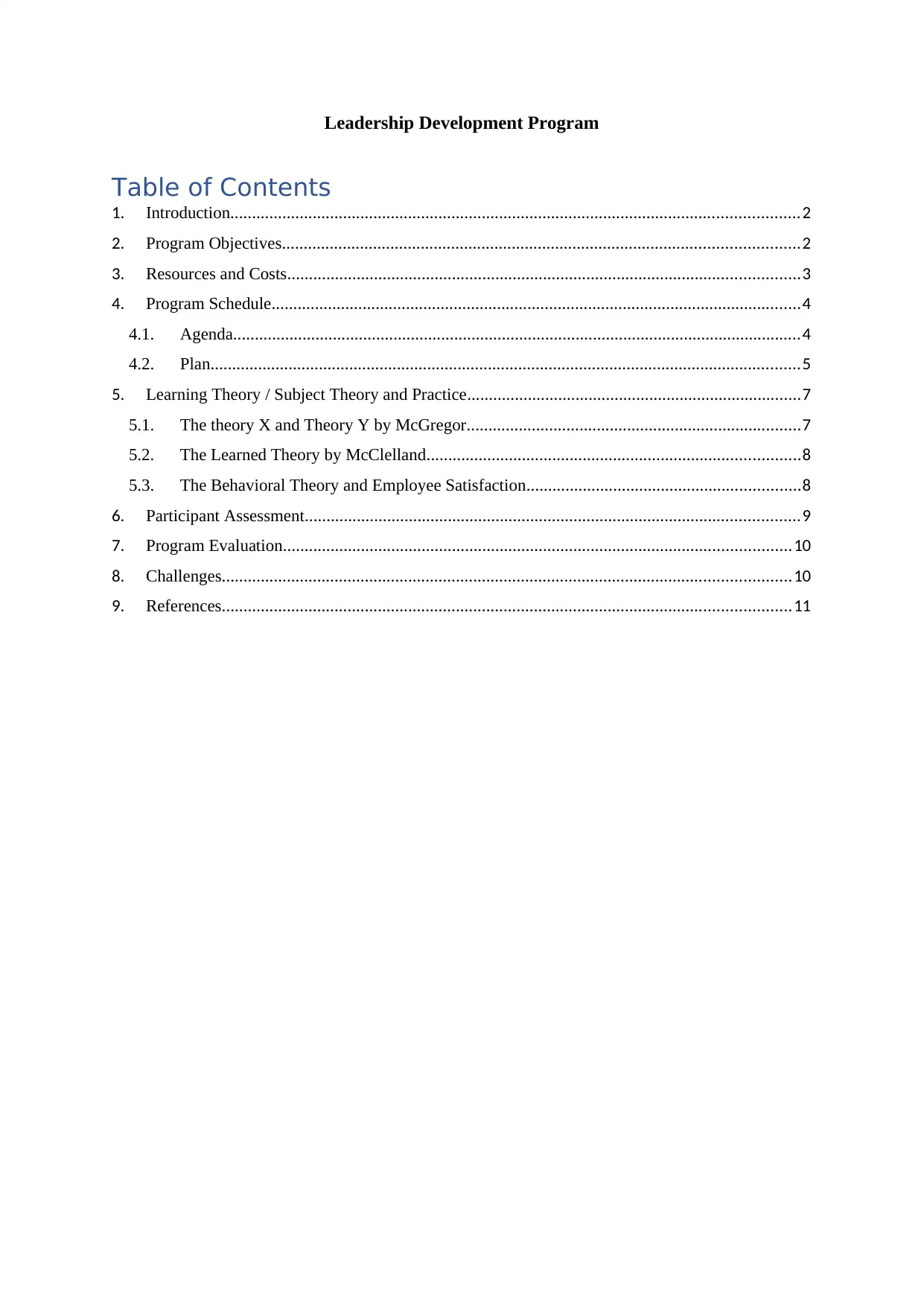
Leadership Development Program
Table of Contents
1. Introduction...................................................................................................................................2
2. Program Objectives.......................................................................................................................2
3. Resources and Costs......................................................................................................................3
4. Program Schedule..........................................................................................................................4
4.1. Agenda...................................................................................................................................4
4.2. Plan........................................................................................................................................5
5. Learning Theory / Subject Theory and Practice.............................................................................7
5.1. The theory X and Theory Y by McGregor.............................................................................7
5.2. The Learned Theory by McClelland......................................................................................8
5.3. The Behavioral Theory and Employee Satisfaction...............................................................8
6. Participant Assessment..................................................................................................................9
7. Program Evaluation.....................................................................................................................10
8. Challenges...................................................................................................................................10
9. References...................................................................................................................................11
Table of Contents
1. Introduction...................................................................................................................................2
2. Program Objectives.......................................................................................................................2
3. Resources and Costs......................................................................................................................3
4. Program Schedule..........................................................................................................................4
4.1. Agenda...................................................................................................................................4
4.2. Plan........................................................................................................................................5
5. Learning Theory / Subject Theory and Practice.............................................................................7
5.1. The theory X and Theory Y by McGregor.............................................................................7
5.2. The Learned Theory by McClelland......................................................................................8
5.3. The Behavioral Theory and Employee Satisfaction...............................................................8
6. Participant Assessment..................................................................................................................9
7. Program Evaluation.....................................................................................................................10
8. Challenges...................................................................................................................................10
9. References...................................................................................................................................11
Paraphrase This Document
Need a fresh take? Get an instant paraphrase of this document with our AI Paraphraser
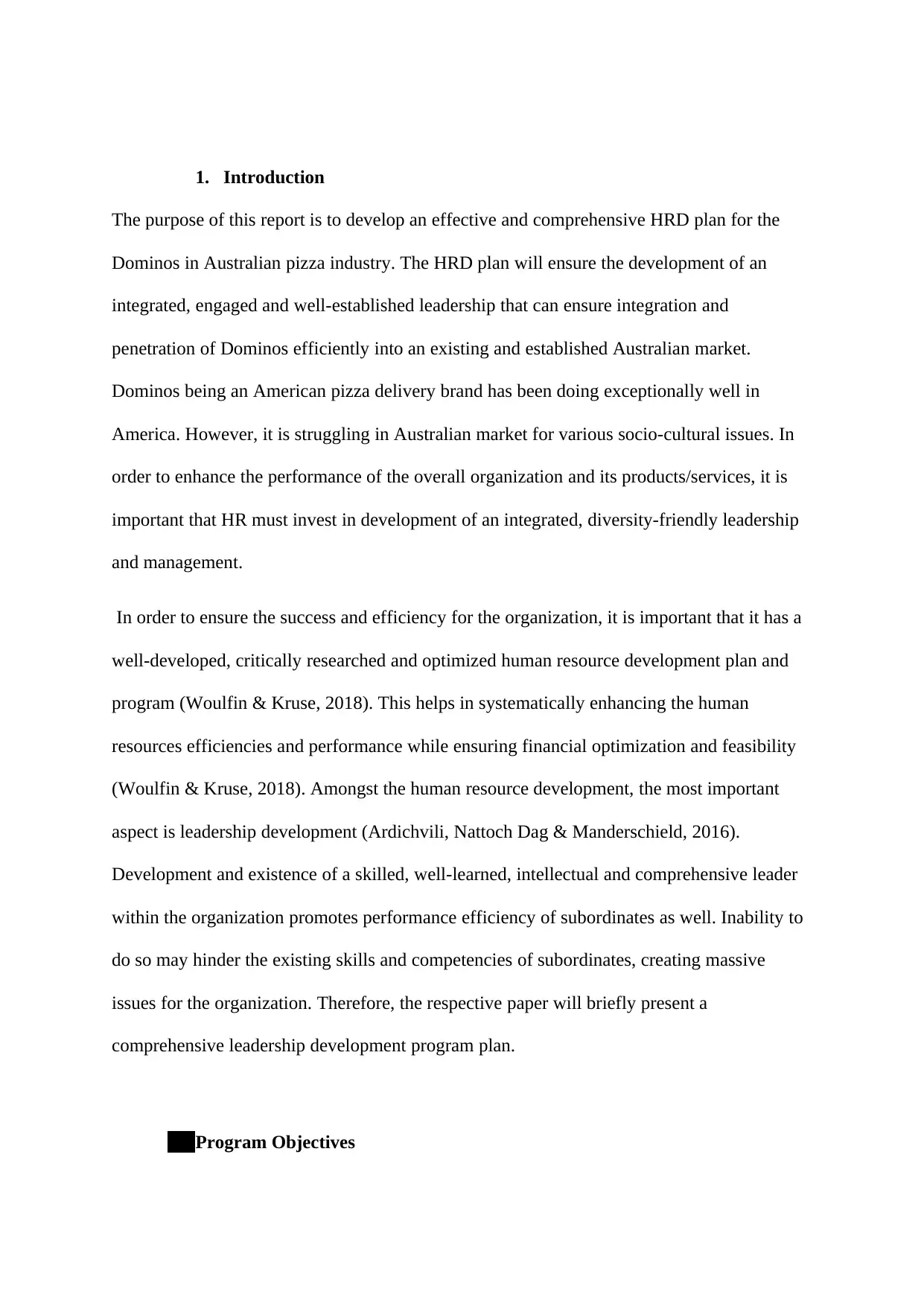
1. Introduction
The purpose of this report is to develop an effective and comprehensive HRD plan for the
Dominos in Australian pizza industry. The HRD plan will ensure the development of an
integrated, engaged and well-established leadership that can ensure integration and
penetration of Dominos efficiently into an existing and established Australian market.
Dominos being an American pizza delivery brand has been doing exceptionally well in
America. However, it is struggling in Australian market for various socio-cultural issues. In
order to enhance the performance of the overall organization and its products/services, it is
important that HR must invest in development of an integrated, diversity-friendly leadership
and management.
In order to ensure the success and efficiency for the organization, it is important that it has a
well-developed, critically researched and optimized human resource development plan and
program (Woulfin & Kruse, 2018). This helps in systematically enhancing the human
resources efficiencies and performance while ensuring financial optimization and feasibility
(Woulfin & Kruse, 2018). Amongst the human resource development, the most important
aspect is leadership development (Ardichvili, Nattoch Dag & Manderschield, 2016).
Development and existence of a skilled, well-learned, intellectual and comprehensive leader
within the organization promotes performance efficiency of subordinates as well. Inability to
do so may hinder the existing skills and competencies of subordinates, creating massive
issues for the organization. Therefore, the respective paper will briefly present a
comprehensive leadership development program plan.
1. Program Objectives
The purpose of this report is to develop an effective and comprehensive HRD plan for the
Dominos in Australian pizza industry. The HRD plan will ensure the development of an
integrated, engaged and well-established leadership that can ensure integration and
penetration of Dominos efficiently into an existing and established Australian market.
Dominos being an American pizza delivery brand has been doing exceptionally well in
America. However, it is struggling in Australian market for various socio-cultural issues. In
order to enhance the performance of the overall organization and its products/services, it is
important that HR must invest in development of an integrated, diversity-friendly leadership
and management.
In order to ensure the success and efficiency for the organization, it is important that it has a
well-developed, critically researched and optimized human resource development plan and
program (Woulfin & Kruse, 2018). This helps in systematically enhancing the human
resources efficiencies and performance while ensuring financial optimization and feasibility
(Woulfin & Kruse, 2018). Amongst the human resource development, the most important
aspect is leadership development (Ardichvili, Nattoch Dag & Manderschield, 2016).
Development and existence of a skilled, well-learned, intellectual and comprehensive leader
within the organization promotes performance efficiency of subordinates as well. Inability to
do so may hinder the existing skills and competencies of subordinates, creating massive
issues for the organization. Therefore, the respective paper will briefly present a
comprehensive leadership development program plan.
1. Program Objectives
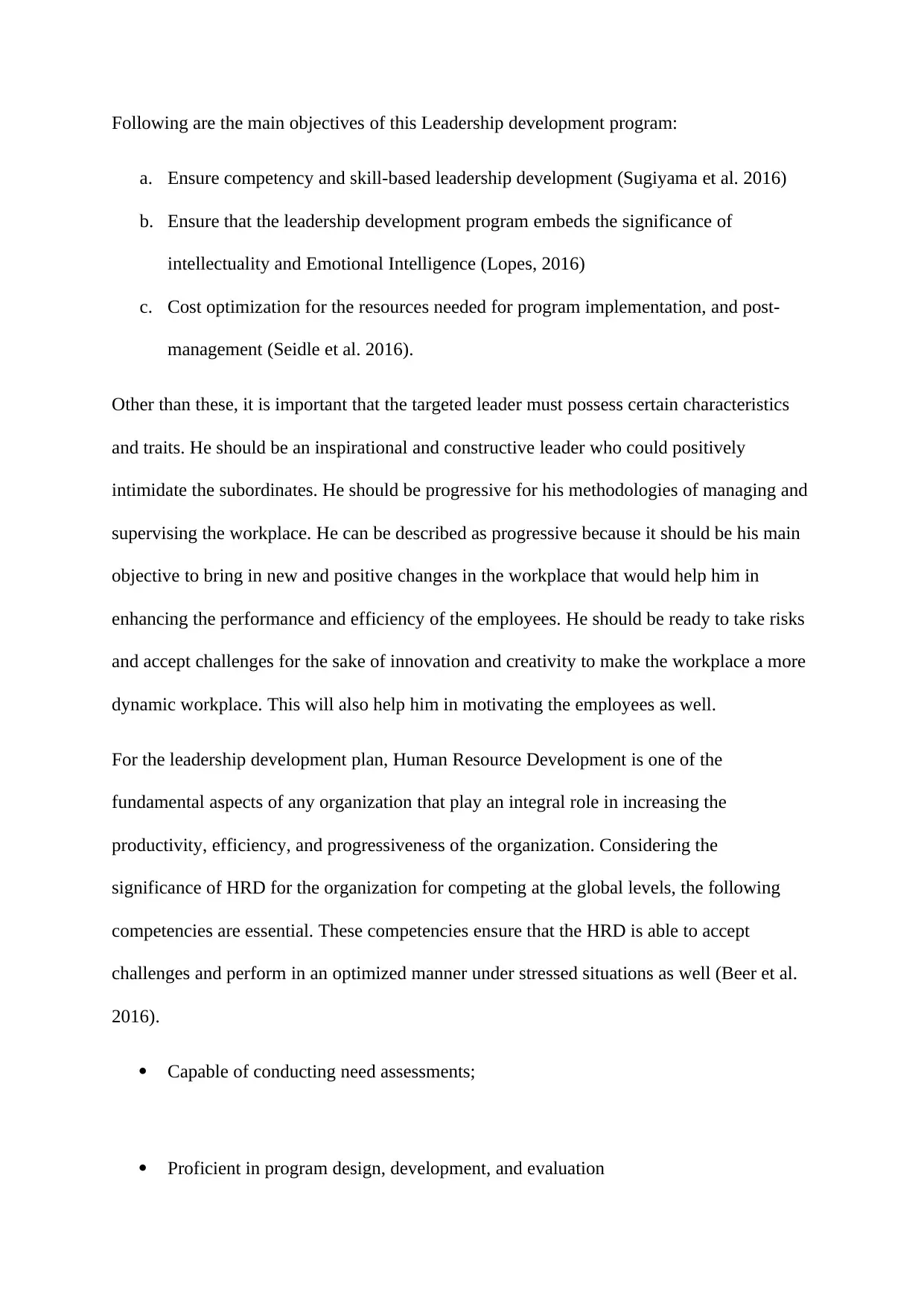
Following are the main objectives of this Leadership development program:
a. Ensure competency and skill-based leadership development (Sugiyama et al. 2016)
b. Ensure that the leadership development program embeds the significance of
intellectuality and Emotional Intelligence (Lopes, 2016)
c. Cost optimization for the resources needed for program implementation, and post-
management (Seidle et al. 2016).
Other than these, it is important that the targeted leader must possess certain characteristics
and traits. He should be an inspirational and constructive leader who could positively
intimidate the subordinates. He should be progressive for his methodologies of managing and
supervising the workplace. He can be described as progressive because it should be his main
objective to bring in new and positive changes in the workplace that would help him in
enhancing the performance and efficiency of the employees. He should be ready to take risks
and accept challenges for the sake of innovation and creativity to make the workplace a more
dynamic workplace. This will also help him in motivating the employees as well.
For the leadership development plan, Human Resource Development is one of the
fundamental aspects of any organization that play an integral role in increasing the
productivity, efficiency, and progressiveness of the organization. Considering the
significance of HRD for the organization for competing at the global levels, the following
competencies are essential. These competencies ensure that the HRD is able to accept
challenges and perform in an optimized manner under stressed situations as well (Beer et al.
2016).
Capable of conducting need assessments;
Proficient in program design, development, and evaluation
a. Ensure competency and skill-based leadership development (Sugiyama et al. 2016)
b. Ensure that the leadership development program embeds the significance of
intellectuality and Emotional Intelligence (Lopes, 2016)
c. Cost optimization for the resources needed for program implementation, and post-
management (Seidle et al. 2016).
Other than these, it is important that the targeted leader must possess certain characteristics
and traits. He should be an inspirational and constructive leader who could positively
intimidate the subordinates. He should be progressive for his methodologies of managing and
supervising the workplace. He can be described as progressive because it should be his main
objective to bring in new and positive changes in the workplace that would help him in
enhancing the performance and efficiency of the employees. He should be ready to take risks
and accept challenges for the sake of innovation and creativity to make the workplace a more
dynamic workplace. This will also help him in motivating the employees as well.
For the leadership development plan, Human Resource Development is one of the
fundamental aspects of any organization that play an integral role in increasing the
productivity, efficiency, and progressiveness of the organization. Considering the
significance of HRD for the organization for competing at the global levels, the following
competencies are essential. These competencies ensure that the HRD is able to accept
challenges and perform in an optimized manner under stressed situations as well (Beer et al.
2016).
Capable of conducting need assessments;
Proficient in program design, development, and evaluation
⊘ This is a preview!⊘
Do you want full access?
Subscribe today to unlock all pages.

Trusted by 1+ million students worldwide
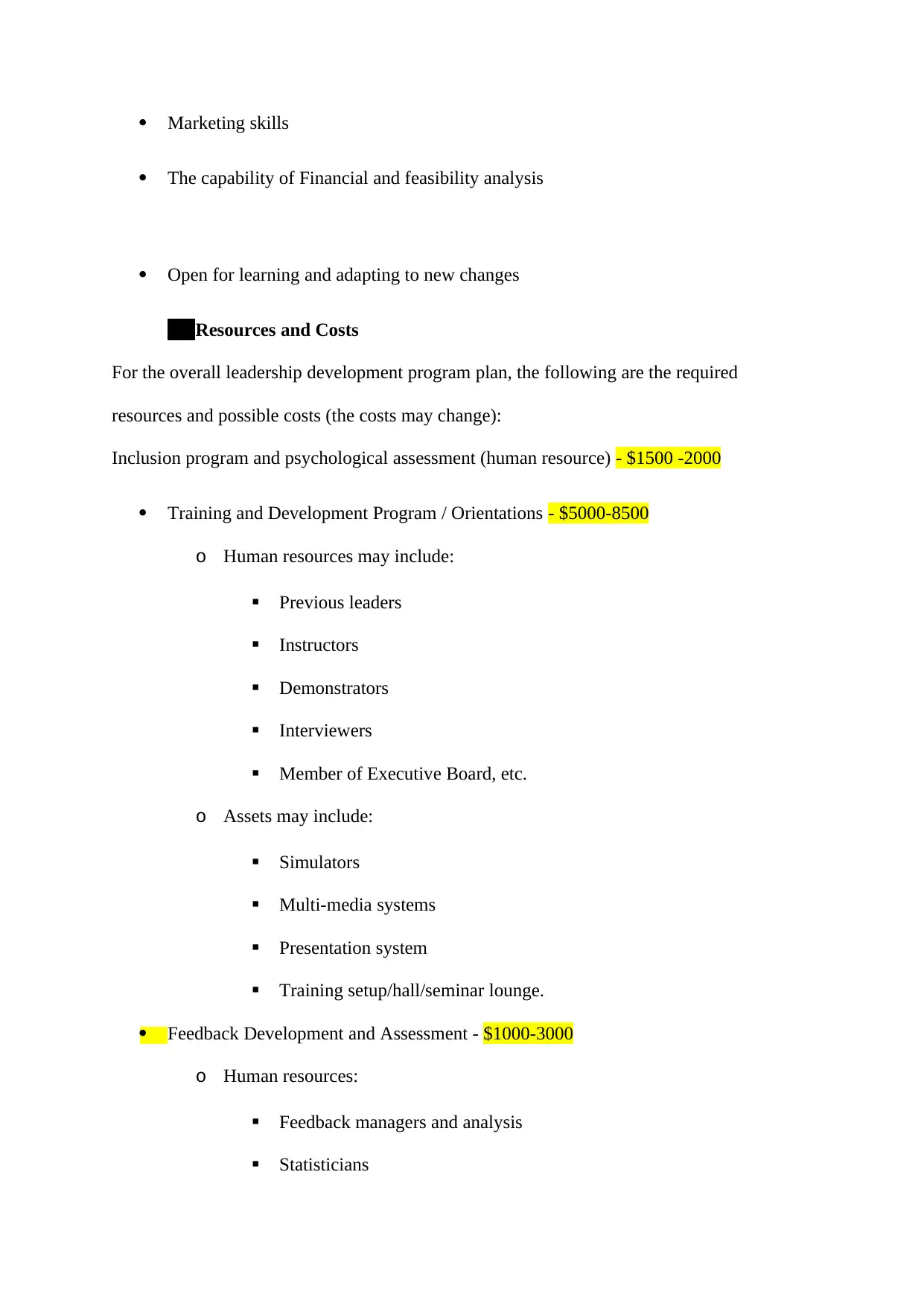
Marketing skills
The capability of Financial and feasibility analysis
Open for learning and adapting to new changes
2. Resources and Costs
For the overall leadership development program plan, the following are the required
resources and possible costs (the costs may change):
Inclusion program and psychological assessment (human resource) - $1500 -2000
Training and Development Program / Orientations - $5000-8500
o Human resources may include:
Previous leaders
Instructors
Demonstrators
Interviewers
Member of Executive Board, etc.
o Assets may include:
Simulators
Multi-media systems
Presentation system
Training setup/hall/seminar lounge.
Feedback Development and Assessment - $1000-3000
o Human resources:
Feedback managers and analysis
Statisticians
The capability of Financial and feasibility analysis
Open for learning and adapting to new changes
2. Resources and Costs
For the overall leadership development program plan, the following are the required
resources and possible costs (the costs may change):
Inclusion program and psychological assessment (human resource) - $1500 -2000
Training and Development Program / Orientations - $5000-8500
o Human resources may include:
Previous leaders
Instructors
Demonstrators
Interviewers
Member of Executive Board, etc.
o Assets may include:
Simulators
Multi-media systems
Presentation system
Training setup/hall/seminar lounge.
Feedback Development and Assessment - $1000-3000
o Human resources:
Feedback managers and analysis
Statisticians
Paraphrase This Document
Need a fresh take? Get an instant paraphrase of this document with our AI Paraphraser
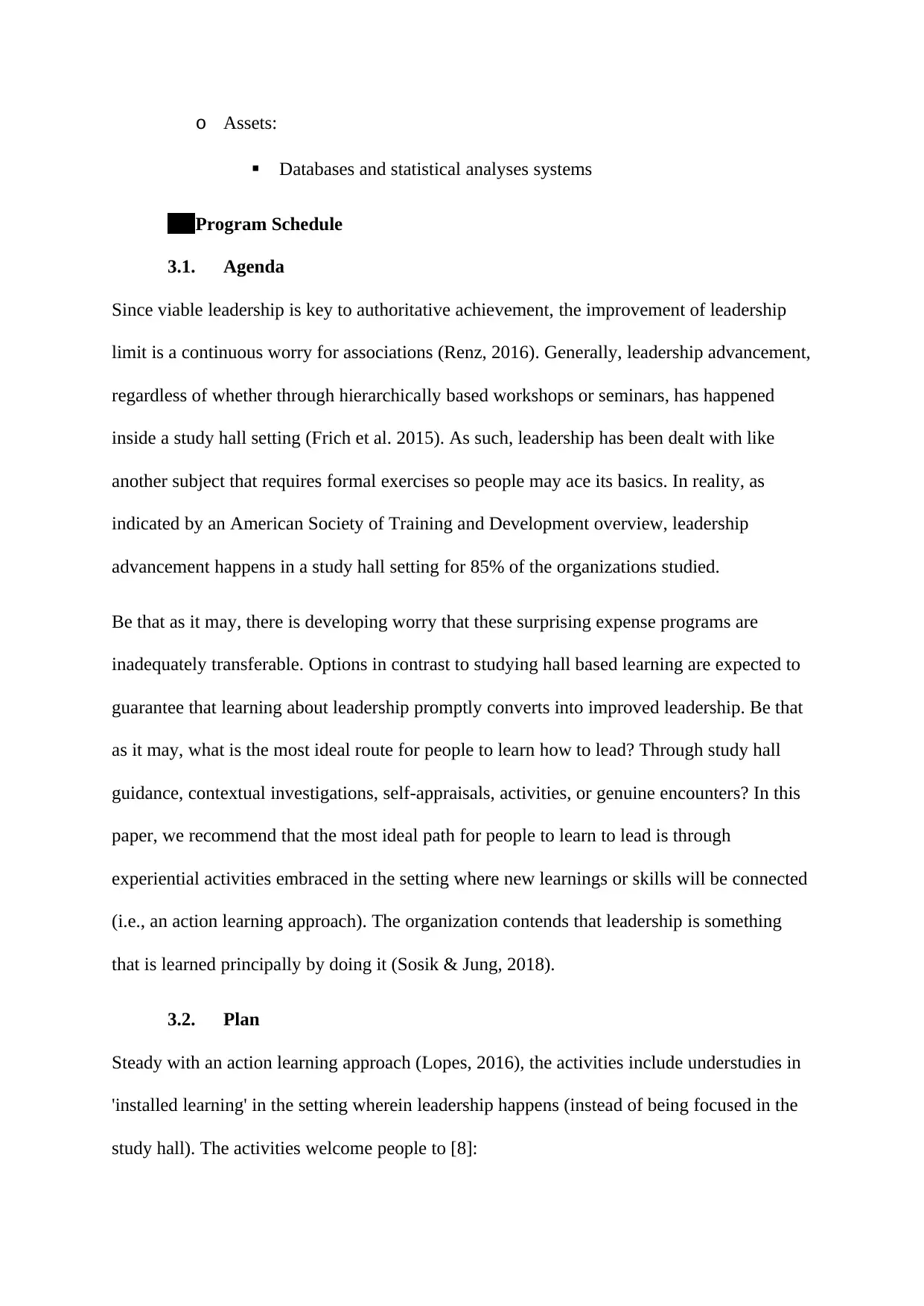
o Assets:
Databases and statistical analyses systems
3. Program Schedule
3.1. Agenda
Since viable leadership is key to authoritative achievement, the improvement of leadership
limit is a continuous worry for associations (Renz, 2016). Generally, leadership advancement,
regardless of whether through hierarchically based workshops or seminars, has happened
inside a study hall setting (Frich et al. 2015). As such, leadership has been dealt with like
another subject that requires formal exercises so people may ace its basics. In reality, as
indicated by an American Society of Training and Development overview, leadership
advancement happens in a study hall setting for 85% of the organizations studied.
Be that as it may, there is developing worry that these surprising expense programs are
inadequately transferable. Options in contrast to studying hall based learning are expected to
guarantee that learning about leadership promptly converts into improved leadership. Be that
as it may, what is the most ideal route for people to learn how to lead? Through study hall
guidance, contextual investigations, self-appraisals, activities, or genuine encounters? In this
paper, we recommend that the most ideal path for people to learn to lead is through
experiential activities embraced in the setting where new learnings or skills will be connected
(i.e., an action learning approach). The organization contends that leadership is something
that is learned principally by doing it (Sosik & Jung, 2018).
3.2. Plan
Steady with an action learning approach (Lopes, 2016), the activities include understudies in
'installed learning' in the setting wherein leadership happens (instead of being focused in the
study hall). The activities welcome people to [8]:
Databases and statistical analyses systems
3. Program Schedule
3.1. Agenda
Since viable leadership is key to authoritative achievement, the improvement of leadership
limit is a continuous worry for associations (Renz, 2016). Generally, leadership advancement,
regardless of whether through hierarchically based workshops or seminars, has happened
inside a study hall setting (Frich et al. 2015). As such, leadership has been dealt with like
another subject that requires formal exercises so people may ace its basics. In reality, as
indicated by an American Society of Training and Development overview, leadership
advancement happens in a study hall setting for 85% of the organizations studied.
Be that as it may, there is developing worry that these surprising expense programs are
inadequately transferable. Options in contrast to studying hall based learning are expected to
guarantee that learning about leadership promptly converts into improved leadership. Be that
as it may, what is the most ideal route for people to learn how to lead? Through study hall
guidance, contextual investigations, self-appraisals, activities, or genuine encounters? In this
paper, we recommend that the most ideal path for people to learn to lead is through
experiential activities embraced in the setting where new learnings or skills will be connected
(i.e., an action learning approach). The organization contends that leadership is something
that is learned principally by doing it (Sosik & Jung, 2018).
3.2. Plan
Steady with an action learning approach (Lopes, 2016), the activities include understudies in
'installed learning' in the setting wherein leadership happens (instead of being focused in the
study hall). The activities welcome people to [8]:
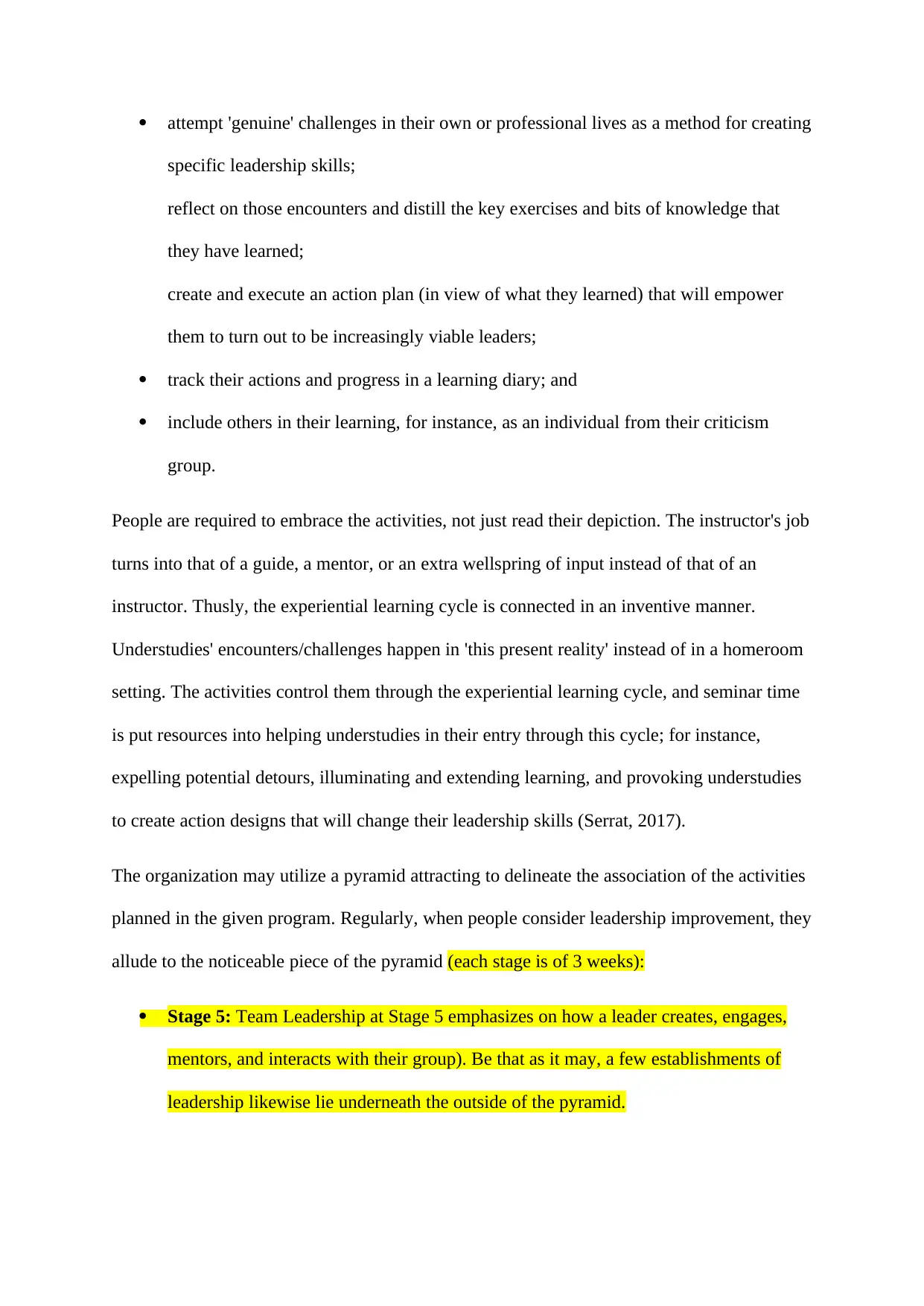
attempt 'genuine' challenges in their own or professional lives as a method for creating
specific leadership skills;
reflect on those encounters and distill the key exercises and bits of knowledge that
they have learned;
create and execute an action plan (in view of what they learned) that will empower
them to turn out to be increasingly viable leaders;
track their actions and progress in a learning diary; and
include others in their learning, for instance, as an individual from their criticism
group.
People are required to embrace the activities, not just read their depiction. The instructor's job
turns into that of a guide, a mentor, or an extra wellspring of input instead of that of an
instructor. Thusly, the experiential learning cycle is connected in an inventive manner.
Understudies' encounters/challenges happen in 'this present reality' instead of in a homeroom
setting. The activities control them through the experiential learning cycle, and seminar time
is put resources into helping understudies in their entry through this cycle; for instance,
expelling potential detours, illuminating and extending learning, and provoking understudies
to create action designs that will change their leadership skills (Serrat, 2017).
The organization may utilize a pyramid attracting to delineate the association of the activities
planned in the given program. Regularly, when people consider leadership improvement, they
allude to the noticeable piece of the pyramid (each stage is of 3 weeks):
Stage 5: Team Leadership at Stage 5 emphasizes on how a leader creates, engages,
mentors, and interacts with their group). Be that as it may, a few establishments of
leadership likewise lie underneath the outside of the pyramid.
specific leadership skills;
reflect on those encounters and distill the key exercises and bits of knowledge that
they have learned;
create and execute an action plan (in view of what they learned) that will empower
them to turn out to be increasingly viable leaders;
track their actions and progress in a learning diary; and
include others in their learning, for instance, as an individual from their criticism
group.
People are required to embrace the activities, not just read their depiction. The instructor's job
turns into that of a guide, a mentor, or an extra wellspring of input instead of that of an
instructor. Thusly, the experiential learning cycle is connected in an inventive manner.
Understudies' encounters/challenges happen in 'this present reality' instead of in a homeroom
setting. The activities control them through the experiential learning cycle, and seminar time
is put resources into helping understudies in their entry through this cycle; for instance,
expelling potential detours, illuminating and extending learning, and provoking understudies
to create action designs that will change their leadership skills (Serrat, 2017).
The organization may utilize a pyramid attracting to delineate the association of the activities
planned in the given program. Regularly, when people consider leadership improvement, they
allude to the noticeable piece of the pyramid (each stage is of 3 weeks):
Stage 5: Team Leadership at Stage 5 emphasizes on how a leader creates, engages,
mentors, and interacts with their group). Be that as it may, a few establishments of
leadership likewise lie underneath the outside of the pyramid.
⊘ This is a preview!⊘
Do you want full access?
Subscribe today to unlock all pages.

Trusted by 1+ million students worldwide
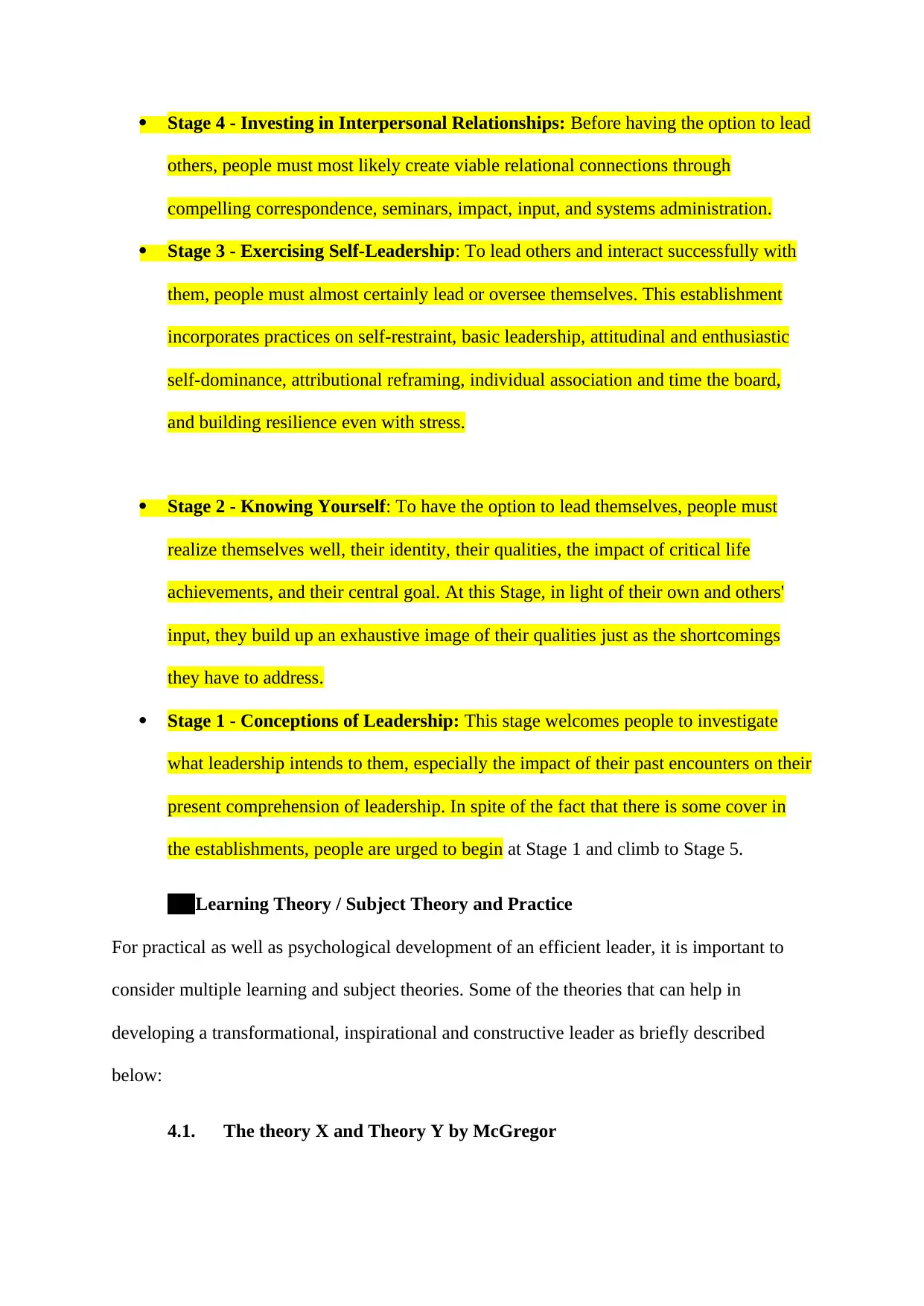
Stage 4 - Investing in Interpersonal Relationships: Before having the option to lead
others, people must most likely create viable relational connections through
compelling correspondence, seminars, impact, input, and systems administration.
Stage 3 - Exercising Self-Leadership: To lead others and interact successfully with
them, people must almost certainly lead or oversee themselves. This establishment
incorporates practices on self-restraint, basic leadership, attitudinal and enthusiastic
self-dominance, attributional reframing, individual association and time the board,
and building resilience even with stress.
Stage 2 - Knowing Yourself: To have the option to lead themselves, people must
realize themselves well, their identity, their qualities, the impact of critical life
achievements, and their central goal. At this Stage, in light of their own and others'
input, they build up an exhaustive image of their qualities just as the shortcomings
they have to address.
Stage 1 - Conceptions of Leadership: This stage welcomes people to investigate
what leadership intends to them, especially the impact of their past encounters on their
present comprehension of leadership. In spite of the fact that there is some cover in
the establishments, people are urged to begin at Stage 1 and climb to Stage 5.
4. Learning Theory / Subject Theory and Practice
For practical as well as psychological development of an efficient leader, it is important to
consider multiple learning and subject theories. Some of the theories that can help in
developing a transformational, inspirational and constructive leader as briefly described
below:
4.1. The theory X and Theory Y by McGregor
others, people must most likely create viable relational connections through
compelling correspondence, seminars, impact, input, and systems administration.
Stage 3 - Exercising Self-Leadership: To lead others and interact successfully with
them, people must almost certainly lead or oversee themselves. This establishment
incorporates practices on self-restraint, basic leadership, attitudinal and enthusiastic
self-dominance, attributional reframing, individual association and time the board,
and building resilience even with stress.
Stage 2 - Knowing Yourself: To have the option to lead themselves, people must
realize themselves well, their identity, their qualities, the impact of critical life
achievements, and their central goal. At this Stage, in light of their own and others'
input, they build up an exhaustive image of their qualities just as the shortcomings
they have to address.
Stage 1 - Conceptions of Leadership: This stage welcomes people to investigate
what leadership intends to them, especially the impact of their past encounters on their
present comprehension of leadership. In spite of the fact that there is some cover in
the establishments, people are urged to begin at Stage 1 and climb to Stage 5.
4. Learning Theory / Subject Theory and Practice
For practical as well as psychological development of an efficient leader, it is important to
consider multiple learning and subject theories. Some of the theories that can help in
developing a transformational, inspirational and constructive leader as briefly described
below:
4.1. The theory X and Theory Y by McGregor
Paraphrase This Document
Need a fresh take? Get an instant paraphrase of this document with our AI Paraphraser
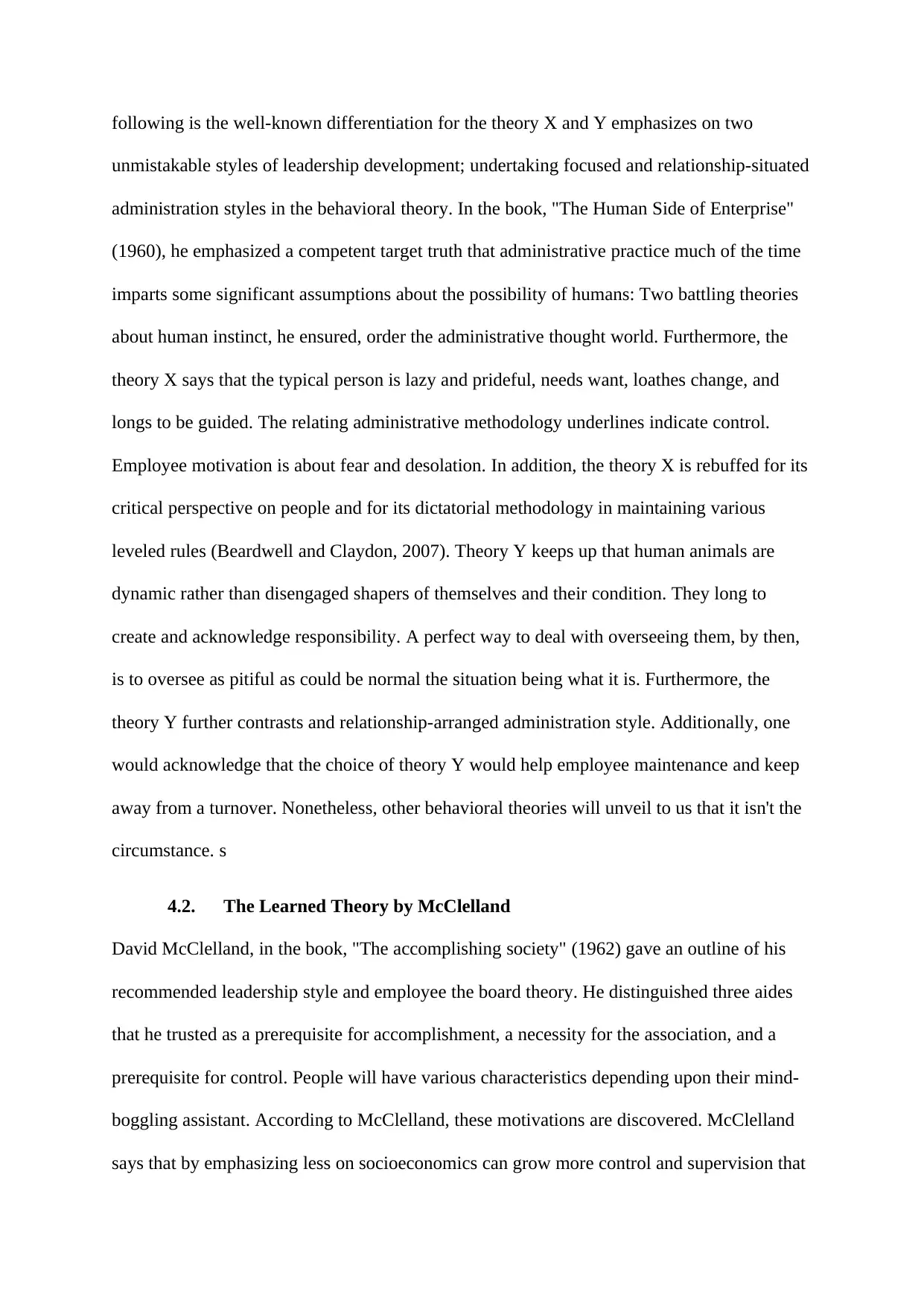
following is the well-known differentiation for the theory X and Y emphasizes on two
unmistakable styles of leadership development; undertaking focused and relationship-situated
administration styles in the behavioral theory. In the book, "The Human Side of Enterprise"
(1960), he emphasized a competent target truth that administrative practice much of the time
imparts some significant assumptions about the possibility of humans: Two battling theories
about human instinct, he ensured, order the administrative thought world. Furthermore, the
theory X says that the typical person is lazy and prideful, needs want, loathes change, and
longs to be guided. The relating administrative methodology underlines indicate control.
Employee motivation is about fear and desolation. In addition, the theory X is rebuffed for its
critical perspective on people and for its dictatorial methodology in maintaining various
leveled rules (Beardwell and Claydon, 2007). Theory Y keeps up that human animals are
dynamic rather than disengaged shapers of themselves and their condition. They long to
create and acknowledge responsibility. A perfect way to deal with overseeing them, by then,
is to oversee as pitiful as could be normal the situation being what it is. Furthermore, the
theory Y further contrasts and relationship-arranged administration style. Additionally, one
would acknowledge that the choice of theory Y would help employee maintenance and keep
away from a turnover. Nonetheless, other behavioral theories will unveil to us that it isn't the
circumstance. s
4.2. The Learned Theory by McClelland
David McClelland, in the book, "The accomplishing society" (1962) gave an outline of his
recommended leadership style and employee the board theory. He distinguished three aides
that he trusted as a prerequisite for accomplishment, a necessity for the association, and a
prerequisite for control. People will have various characteristics depending upon their mind-
boggling assistant. According to McClelland, these motivations are discovered. McClelland
says that by emphasizing less on socioeconomics can grow more control and supervision that
unmistakable styles of leadership development; undertaking focused and relationship-situated
administration styles in the behavioral theory. In the book, "The Human Side of Enterprise"
(1960), he emphasized a competent target truth that administrative practice much of the time
imparts some significant assumptions about the possibility of humans: Two battling theories
about human instinct, he ensured, order the administrative thought world. Furthermore, the
theory X says that the typical person is lazy and prideful, needs want, loathes change, and
longs to be guided. The relating administrative methodology underlines indicate control.
Employee motivation is about fear and desolation. In addition, the theory X is rebuffed for its
critical perspective on people and for its dictatorial methodology in maintaining various
leveled rules (Beardwell and Claydon, 2007). Theory Y keeps up that human animals are
dynamic rather than disengaged shapers of themselves and their condition. They long to
create and acknowledge responsibility. A perfect way to deal with overseeing them, by then,
is to oversee as pitiful as could be normal the situation being what it is. Furthermore, the
theory Y further contrasts and relationship-arranged administration style. Additionally, one
would acknowledge that the choice of theory Y would help employee maintenance and keep
away from a turnover. Nonetheless, other behavioral theories will unveil to us that it isn't the
circumstance. s
4.2. The Learned Theory by McClelland
David McClelland, in the book, "The accomplishing society" (1962) gave an outline of his
recommended leadership style and employee the board theory. He distinguished three aides
that he trusted as a prerequisite for accomplishment, a necessity for the association, and a
prerequisite for control. People will have various characteristics depending upon their mind-
boggling assistant. According to McClelland, these motivations are discovered. McClelland
says that by emphasizing less on socioeconomics can grow more control and supervision that
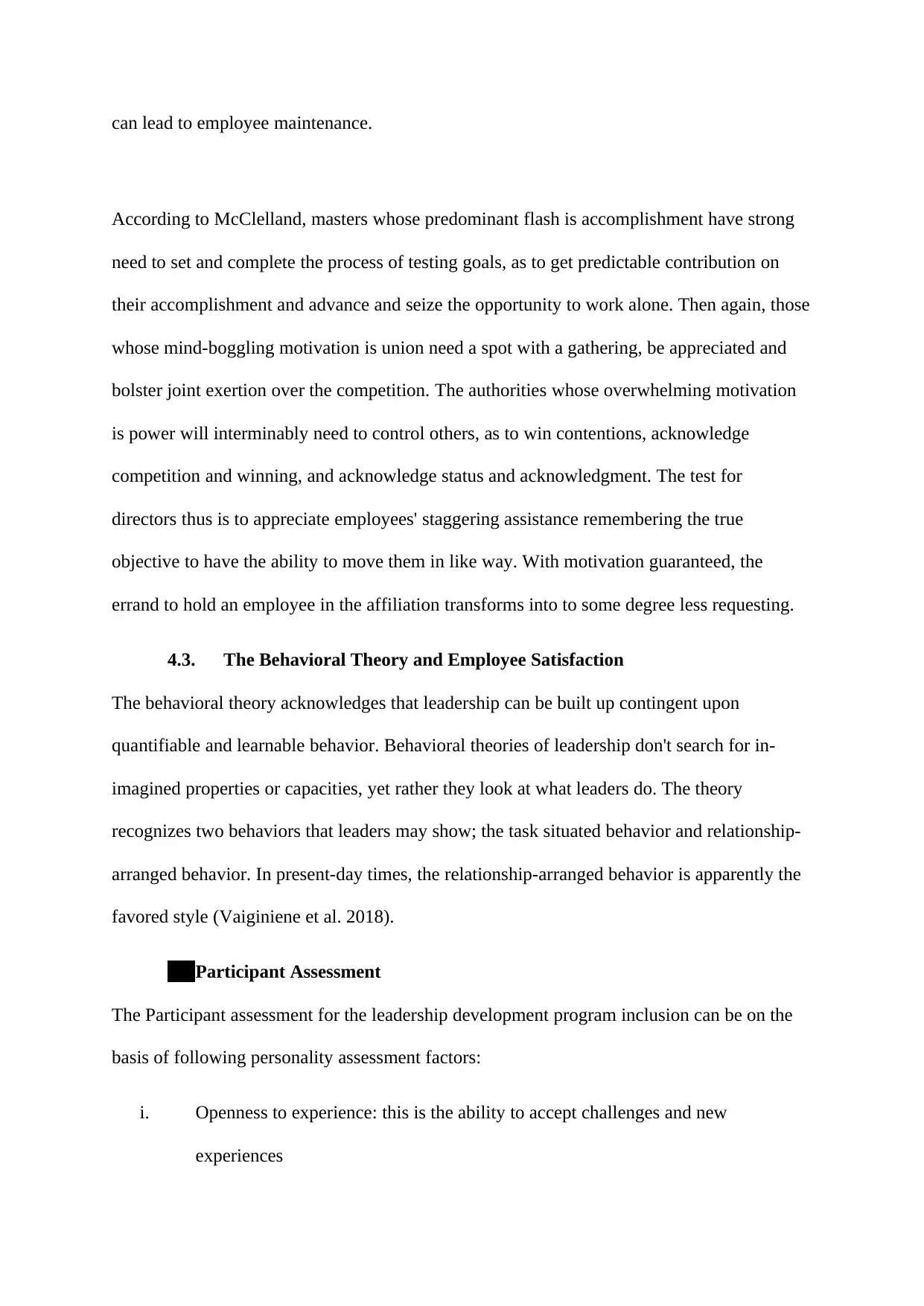
can lead to employee maintenance.
According to McClelland, masters whose predominant flash is accomplishment have strong
need to set and complete the process of testing goals, as to get predictable contribution on
their accomplishment and advance and seize the opportunity to work alone. Then again, those
whose mind-boggling motivation is union need a spot with a gathering, be appreciated and
bolster joint exertion over the competition. The authorities whose overwhelming motivation
is power will interminably need to control others, as to win contentions, acknowledge
competition and winning, and acknowledge status and acknowledgment. The test for
directors thus is to appreciate employees' staggering assistance remembering the true
objective to have the ability to move them in like way. With motivation guaranteed, the
errand to hold an employee in the affiliation transforms into to some degree less requesting.
4.3. The Behavioral Theory and Employee Satisfaction
The behavioral theory acknowledges that leadership can be built up contingent upon
quantifiable and learnable behavior. Behavioral theories of leadership don't search for in-
imagined properties or capacities, yet rather they look at what leaders do. The theory
recognizes two behaviors that leaders may show; the task situated behavior and relationship-
arranged behavior. In present-day times, the relationship-arranged behavior is apparently the
favored style (Vaiginiene et al. 2018).
5. Participant Assessment
The Participant assessment for the leadership development program inclusion can be on the
basis of following personality assessment factors:
i. Openness to experience: this is the ability to accept challenges and new
experiences
According to McClelland, masters whose predominant flash is accomplishment have strong
need to set and complete the process of testing goals, as to get predictable contribution on
their accomplishment and advance and seize the opportunity to work alone. Then again, those
whose mind-boggling motivation is union need a spot with a gathering, be appreciated and
bolster joint exertion over the competition. The authorities whose overwhelming motivation
is power will interminably need to control others, as to win contentions, acknowledge
competition and winning, and acknowledge status and acknowledgment. The test for
directors thus is to appreciate employees' staggering assistance remembering the true
objective to have the ability to move them in like way. With motivation guaranteed, the
errand to hold an employee in the affiliation transforms into to some degree less requesting.
4.3. The Behavioral Theory and Employee Satisfaction
The behavioral theory acknowledges that leadership can be built up contingent upon
quantifiable and learnable behavior. Behavioral theories of leadership don't search for in-
imagined properties or capacities, yet rather they look at what leaders do. The theory
recognizes two behaviors that leaders may show; the task situated behavior and relationship-
arranged behavior. In present-day times, the relationship-arranged behavior is apparently the
favored style (Vaiginiene et al. 2018).
5. Participant Assessment
The Participant assessment for the leadership development program inclusion can be on the
basis of following personality assessment factors:
i. Openness to experience: this is the ability to accept challenges and new
experiences
⊘ This is a preview!⊘
Do you want full access?
Subscribe today to unlock all pages.

Trusted by 1+ million students worldwide
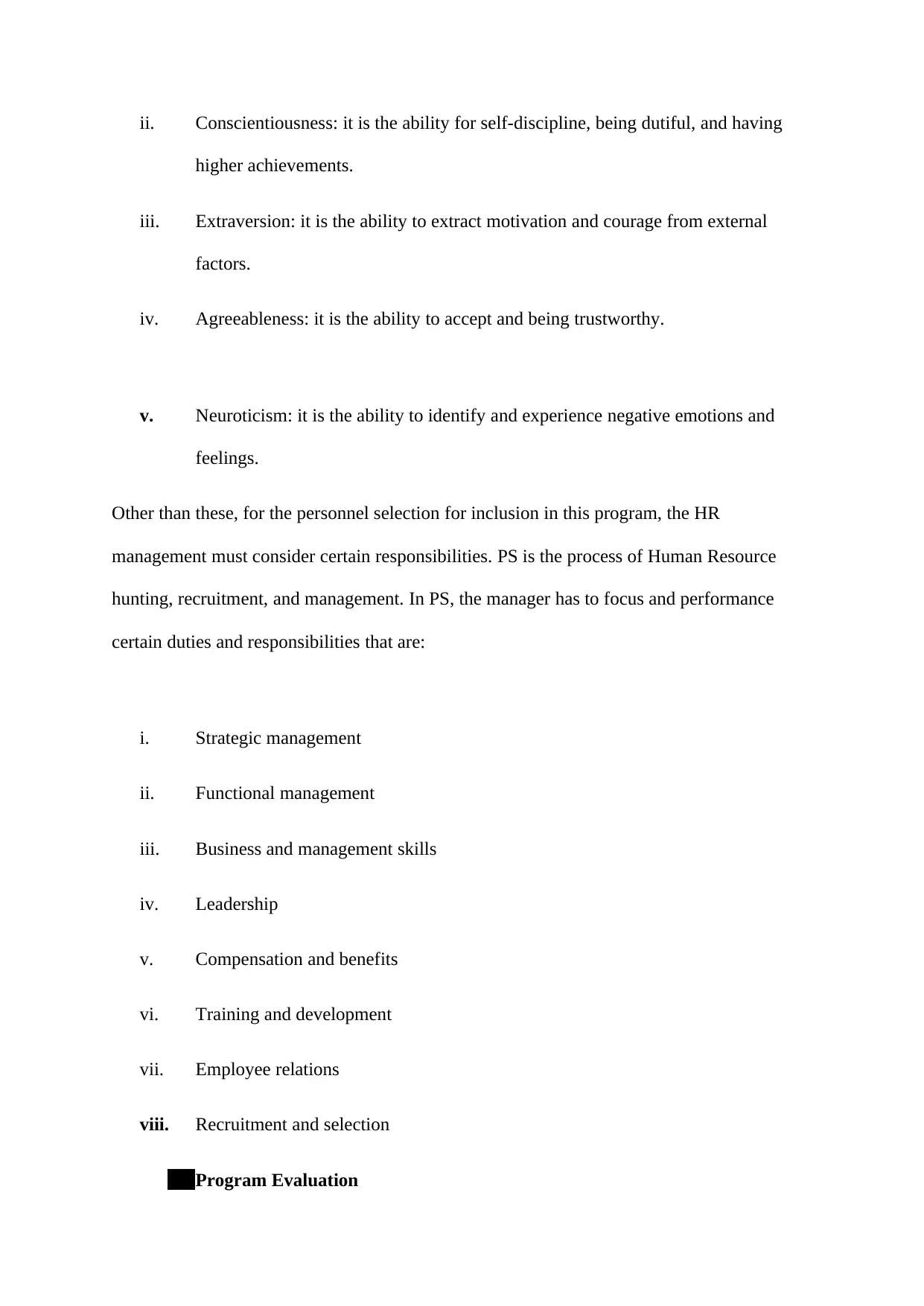
ii. Conscientiousness: it is the ability for self-discipline, being dutiful, and having
higher achievements.
iii. Extraversion: it is the ability to extract motivation and courage from external
factors.
iv. Agreeableness: it is the ability to accept and being trustworthy.
v. Neuroticism: it is the ability to identify and experience negative emotions and
feelings.
Other than these, for the personnel selection for inclusion in this program, the HR
management must consider certain responsibilities. PS is the process of Human Resource
hunting, recruitment, and management. In PS, the manager has to focus and performance
certain duties and responsibilities that are:
i. Strategic management
ii. Functional management
iii. Business and management skills
iv. Leadership
v. Compensation and benefits
vi. Training and development
vii. Employee relations
viii. Recruitment and selection
6. Program Evaluation
higher achievements.
iii. Extraversion: it is the ability to extract motivation and courage from external
factors.
iv. Agreeableness: it is the ability to accept and being trustworthy.
v. Neuroticism: it is the ability to identify and experience negative emotions and
feelings.
Other than these, for the personnel selection for inclusion in this program, the HR
management must consider certain responsibilities. PS is the process of Human Resource
hunting, recruitment, and management. In PS, the manager has to focus and performance
certain duties and responsibilities that are:
i. Strategic management
ii. Functional management
iii. Business and management skills
iv. Leadership
v. Compensation and benefits
vi. Training and development
vii. Employee relations
viii. Recruitment and selection
6. Program Evaluation
Paraphrase This Document
Need a fresh take? Get an instant paraphrase of this document with our AI Paraphraser
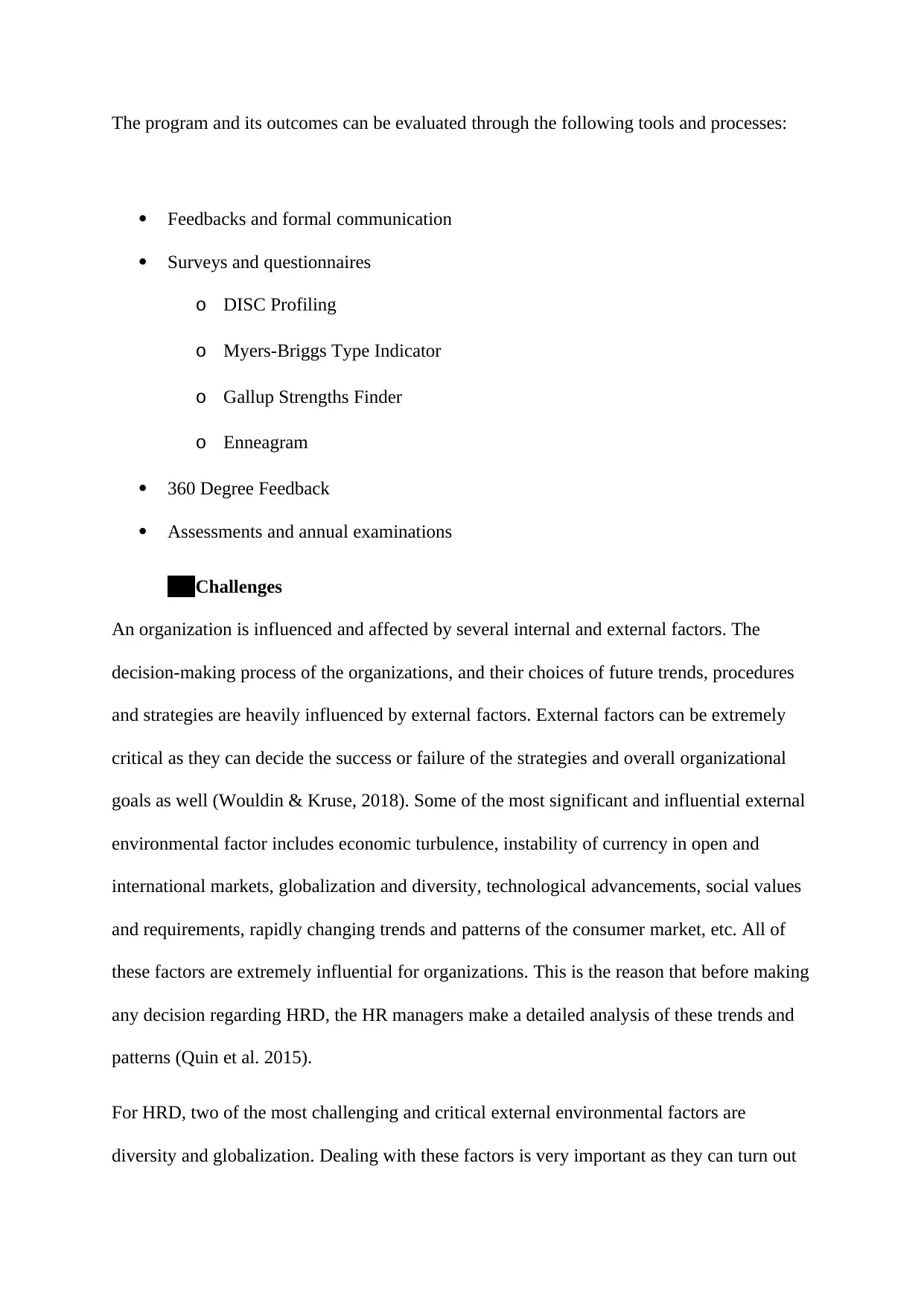
The program and its outcomes can be evaluated through the following tools and processes:
Feedbacks and formal communication
Surveys and questionnaires
o DISC Profiling
o Myers-Briggs Type Indicator
o Gallup Strengths Finder
o Enneagram
360 Degree Feedback
Assessments and annual examinations
7. Challenges
An organization is influenced and affected by several internal and external factors. The
decision-making process of the organizations, and their choices of future trends, procedures
and strategies are heavily influenced by external factors. External factors can be extremely
critical as they can decide the success or failure of the strategies and overall organizational
goals as well (Wouldin & Kruse, 2018). Some of the most significant and influential external
environmental factor includes economic turbulence, instability of currency in open and
international markets, globalization and diversity, technological advancements, social values
and requirements, rapidly changing trends and patterns of the consumer market, etc. All of
these factors are extremely influential for organizations. This is the reason that before making
any decision regarding HRD, the HR managers make a detailed analysis of these trends and
patterns (Quin et al. 2015).
For HRD, two of the most challenging and critical external environmental factors are
diversity and globalization. Dealing with these factors is very important as they can turn out
Feedbacks and formal communication
Surveys and questionnaires
o DISC Profiling
o Myers-Briggs Type Indicator
o Gallup Strengths Finder
o Enneagram
360 Degree Feedback
Assessments and annual examinations
7. Challenges
An organization is influenced and affected by several internal and external factors. The
decision-making process of the organizations, and their choices of future trends, procedures
and strategies are heavily influenced by external factors. External factors can be extremely
critical as they can decide the success or failure of the strategies and overall organizational
goals as well (Wouldin & Kruse, 2018). Some of the most significant and influential external
environmental factor includes economic turbulence, instability of currency in open and
international markets, globalization and diversity, technological advancements, social values
and requirements, rapidly changing trends and patterns of the consumer market, etc. All of
these factors are extremely influential for organizations. This is the reason that before making
any decision regarding HRD, the HR managers make a detailed analysis of these trends and
patterns (Quin et al. 2015).
For HRD, two of the most challenging and critical external environmental factors are
diversity and globalization. Dealing with these factors is very important as they can turn out
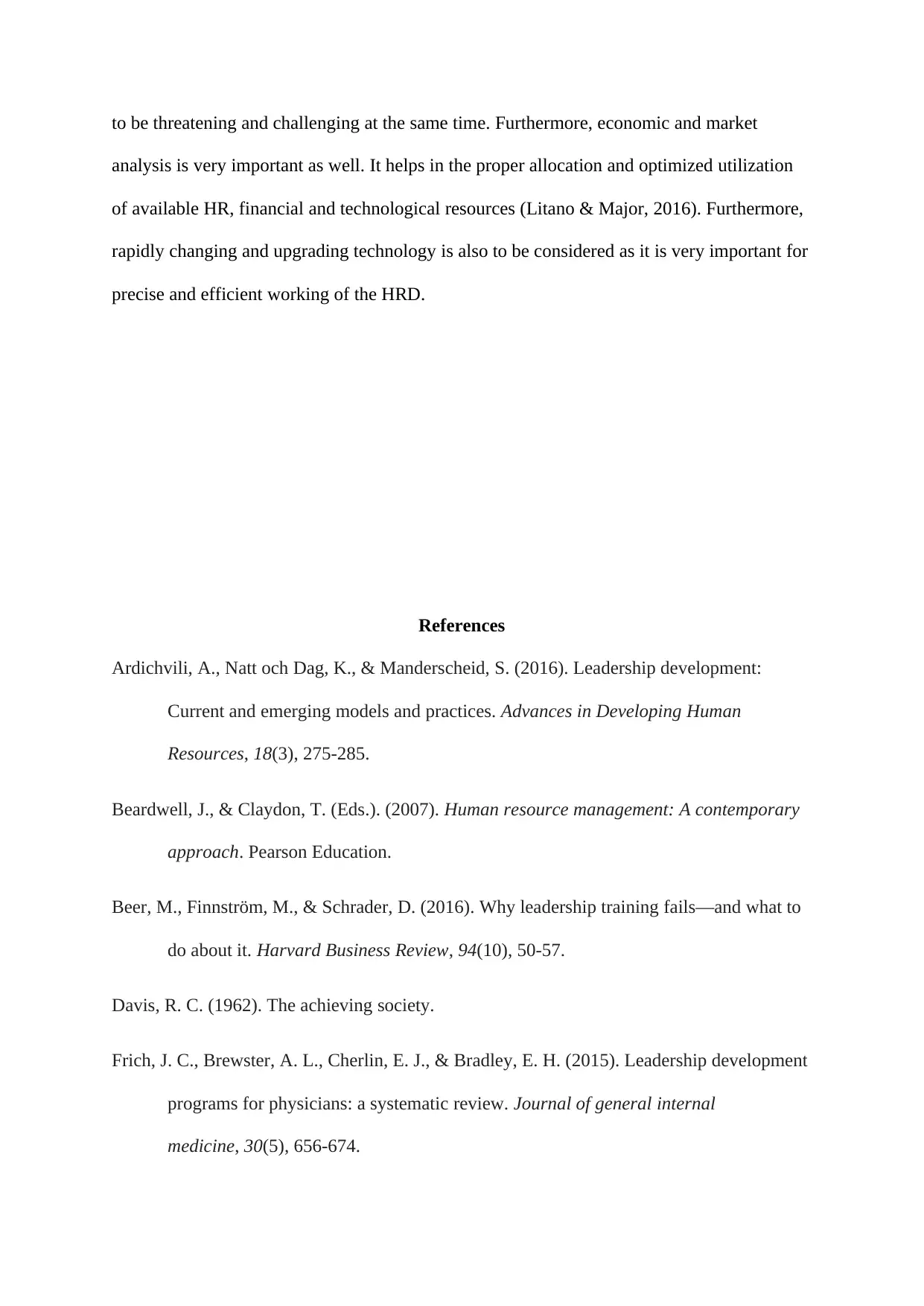
to be threatening and challenging at the same time. Furthermore, economic and market
analysis is very important as well. It helps in the proper allocation and optimized utilization
of available HR, financial and technological resources (Litano & Major, 2016). Furthermore,
rapidly changing and upgrading technology is also to be considered as it is very important for
precise and efficient working of the HRD.
References
Ardichvili, A., Natt och Dag, K., & Manderscheid, S. (2016). Leadership development:
Current and emerging models and practices. Advances in Developing Human
Resources, 18(3), 275-285.
Beardwell, J., & Claydon, T. (Eds.). (2007). Human resource management: A contemporary
approach. Pearson Education.
Beer, M., Finnström, M., & Schrader, D. (2016). Why leadership training fails—and what to
do about it. Harvard Business Review, 94(10), 50-57.
Davis, R. C. (1962). The achieving society.
Frich, J. C., Brewster, A. L., Cherlin, E. J., & Bradley, E. H. (2015). Leadership development
programs for physicians: a systematic review. Journal of general internal
medicine, 30(5), 656-674.
analysis is very important as well. It helps in the proper allocation and optimized utilization
of available HR, financial and technological resources (Litano & Major, 2016). Furthermore,
rapidly changing and upgrading technology is also to be considered as it is very important for
precise and efficient working of the HRD.
References
Ardichvili, A., Natt och Dag, K., & Manderscheid, S. (2016). Leadership development:
Current and emerging models and practices. Advances in Developing Human
Resources, 18(3), 275-285.
Beardwell, J., & Claydon, T. (Eds.). (2007). Human resource management: A contemporary
approach. Pearson Education.
Beer, M., Finnström, M., & Schrader, D. (2016). Why leadership training fails—and what to
do about it. Harvard Business Review, 94(10), 50-57.
Davis, R. C. (1962). The achieving society.
Frich, J. C., Brewster, A. L., Cherlin, E. J., & Bradley, E. H. (2015). Leadership development
programs for physicians: a systematic review. Journal of general internal
medicine, 30(5), 656-674.
⊘ This is a preview!⊘
Do you want full access?
Subscribe today to unlock all pages.

Trusted by 1+ million students worldwide
1 out of 14
Related Documents
Your All-in-One AI-Powered Toolkit for Academic Success.
+13062052269
info@desklib.com
Available 24*7 on WhatsApp / Email
![[object Object]](/_next/static/media/star-bottom.7253800d.svg)
Unlock your academic potential
Copyright © 2020–2025 A2Z Services. All Rights Reserved. Developed and managed by ZUCOL.





